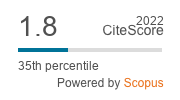Determination of Trace Amount of Lead in Industrial and Municipal Effluent Water Samples Based on Dispersive Liquid-Liquid Extraction
DOI:
https://doi.org/10.29356/jmcs.v58i2.169Keywords:
Lead, dispersive liquid-liquid extraction, tetraethylthiuram disulfide, flame atomic absorption spectrometry, water samplesAbstract
In this study, a simple, sensitive and accurate method was developed for the determination of lead ion by combining ionic liquid dispersive liquid-liquid extraction (IL-DLLE) with flame atomic absorption spectrometry. Tetraethylthiuram disulfide (TETD), acetone and 1-octyl-3-methylimidazolium hexafluorophosphate [(C8MIM) (PF6)] were used as the chelating agent, dispersive and extraction solvent, respectively. Under the optimal onditions, the calibration graph was linear in the range of 5-190 μg L-1 of lead and the detection limit was 0.8 μg L-1 with a sample volume of 200 mL. The proposed method was validated by the analysis of one certified reference material and applied successfully to the determination of lead in real water samples.Downloads
Downloads
Published
Issue
Section
License
Authors who publish with this journal agree to the following terms:
- Authors retain copyright and grant the journal right of first publication with the work simultaneously licensed under a Creative Commons Attribution License that allows others to share the work with an acknowledgement of the work's authorship and initial publication in this journal.
- Authors are able to enter into separate, additional contractual arrangements for the non-exclusive distribution of the journal's published version of the work (e.g., post it to an institutional repository or publish it in a book), with an acknowledgement of its initial publication in this journal.









